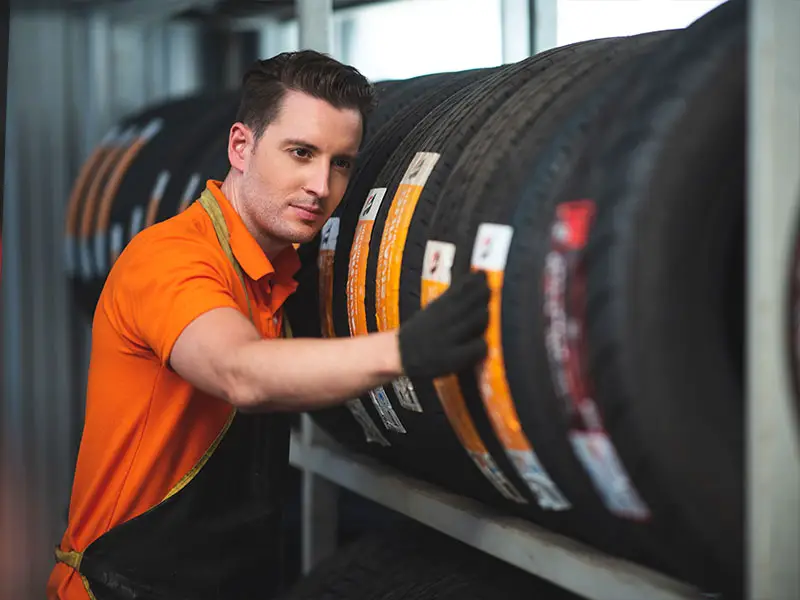It’s hard to be sure what someone means when they ask about the different types of tires. They could be referring to 1 of 3 aspects of tires:
Types Of Tires
3 main types of passenger and light truck tiresCommon variations of the main types
- All-Season
- Summer
- Winter
- Touring
- Performance
- Passenger
- All-Terrain
- Off-Road
Chances are you don’t really care whether a tire is bias ply or radial. You probably know if you need a Passenger, Light Truck, Trailer, or Spare tire. What you probably want to know about are the differences between All-Season, Summer, and Winter tires and the various designs within these 3 tire types.
Let’s dive into the meat and potatoes of all-season, summer, and winter tires and then we’ll cover the other types.
3 Primary Types Of Tires
Here’s where we dive into the questions most people have about different types of tires. Most passenger tires fall into one of 3 main types:
- All-Season
- Summer
- Winter
All-season, summer, and winter are the 3 main types of tires used on passenger cars, trucks, and SUVs. Of these 3 types, all-season is the most popular.
There are several common designs within these 3 tire types. Some examples are:
- Touring
- Performance
- Passenger
- All-terrain
- Off-road
Let’s not get ahead of ourselves, though. First, we’ll go over each of the 3 main tire types:

MICHELIN CrossClimate2 All-Season
All-Season Tires
All-season tires are the jack-of-all-trades tire found on most passenger cars, trucks, and SUVs. These tires are designed to be used all year round in climates that don’t experience freezing temperatures often. However, they are designed to handle summer heat as well as mild winter conditions and some light snow.
All-season tires are not ideal for freezing climates as the rubber isn’t formulated to remain pliable as temperatures drop to near freezing or beyond. A winter tire is a better choice for more extreme winter climates that frequently see temperatures below freezing in colder months.
While an all-season tire can handle hot summer days without any adverse side effects, they aren’t quite as optimized to get the most benefits possible during warmer days.
As with most things, a tire that tries to do everything well will have to make compromises. Therefore a dedicated winter tire will perform better in winter, and a summer tire will perform better when the temperatures are well above freezing.

Michelin Pilot Sport 4 S Summer
Summer Tires
Summer tires, as the name suggests, are tires that perform well in summer weather. They aren’t limited to summer use only, though. They’re meant for use in temperatures well above freezing and beyond. They are not designed to handle snow and ice and shouldn’t be used in winter conditions.
For the majority of the year, summer tires perform better than all-season tires since they don’t need to account for occasional snow conditions and can prioritize rubber compounds that don’t need to remain flexible in the cold.
The benefits are better warm and wet weather traction as well as longer tread life. They’re an excellent choice for switching tires when winter is over in harsher winter climates and the perfect choice year-round in hot climates that rarely experience freezing conditions.
High-performance street tires are most commonly summer tires. Summer tires can focus the tread patterns and rubber compounds on getting the most grip and life out of a tire without compromising to perform in winter conditions.

Michelin X-Ice Xi3 Winter
Winter Tires
I’m sure you know by now that winter tires are designed to work best in below-freezing conditions and handle well in snow and ice. Tread patterns and rubber compounds are optimized to provide the best traction possible in cold weather and better deal with winter snow and slush.
Often, winter tires contain sipes that are small slits that help with traction during harsh cold weather. The rubber compound used is also designed to remain pliable at cold temperatures to help grip and handling.
It’s important to know that winter tires are a terrible choice for use in seasons other than winter. Not only will the tread pattern be much less able to grip well in the rain than an all-season or summer tire, but the rubber compound is way too soft for warmer temperatures.
The softer compound will wear out substantially faster. Also, the tread blocks will flex far more than they should and cause the tires to give up traction quickly.
Tire Designs
Within the 3 types of tires, there are many designs. Let’s cover the more popular designs and work our way down the list.
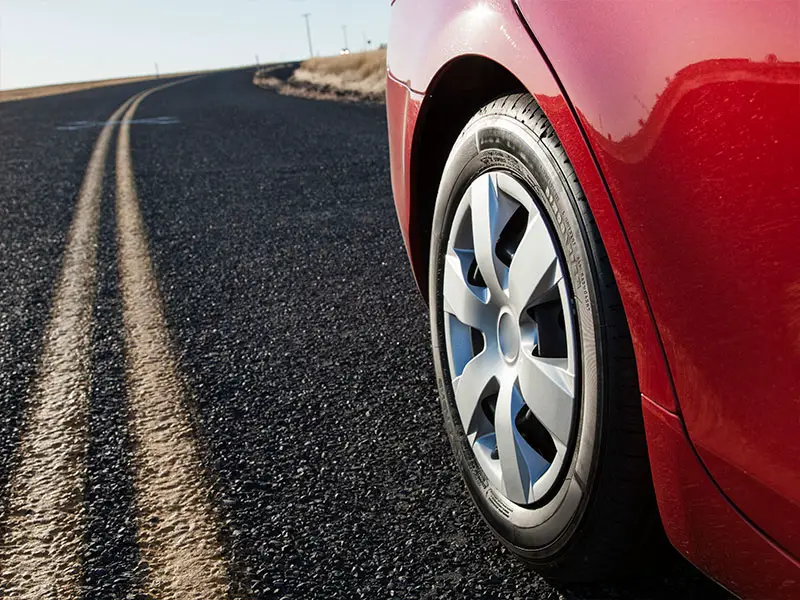
Touring Tires
Touring tires are designed to be quiet, comfortable, good in wet and dry conditions, and long-lasting. They are the most popular design available in all 3 of the different types of tires. Touring tires attempt to balance all of the aspects that make a tire suitable.
If you’re considering an all-season touring tire, you’re asking a lot of it. It’s a tire that’s designed to be good at everything. Generally, they are exceptional at being able to perform well in almost any condition they’ll encounter.
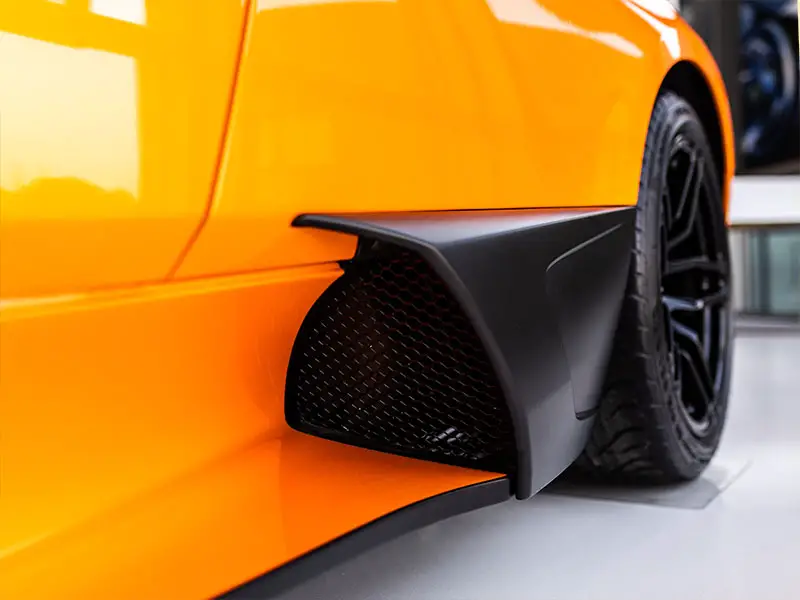
Performance Tires
Performance tires prioritize handling and traction over more extended tread wear. They are also designed to withstand higher speeds and have a higher rating, such as VR or ZR. They are most often found as a summer tire, but they can also be found in all-season variations.
Performance tires typically are offered in several progressively more advanced grades:
- Standard Performance
- High Performance
- Ultra-High Performance
- Max Performance
Standard Performance tires are the mildest option and attempt to trade off as little tread life as possible while increasing handling and traction as much as possible. They tend to focus on tread patterns more than rubber compounds to improve performance characteristics. Standard performance tires will be available in both Summer and All-Season flavors.
You trade off more tread life for handling and grip as you progress up toward Max Performance tires. Tread patterns become more advanced, and rubber compounds become softer and last fewer miles before wearing out.
Max Performance tires have the shortest tread life and the best grip of the street-legal tires. You can even use them for some occasional track events though they aren’t a dedicated track tire.
I recommend sticking with the tire type that your vehicle came with from the factory for most people.
TireGrades Expert Tip
You’ll know if you’re an exception to this rule.
Passenger Tires
Passenger Tires focus on ride quality, comfort, noise, efficiency, and tire life. Performance qualities are good but not as optimized as they are with touring or performance tires.
You can expect a quality passenger tire to essentially be as unobtrusive as possible while still doing its job effectively. They will often be used on low performance sedans, SUVs, and mini vans that rarely have a need to for above average performance characteristics.
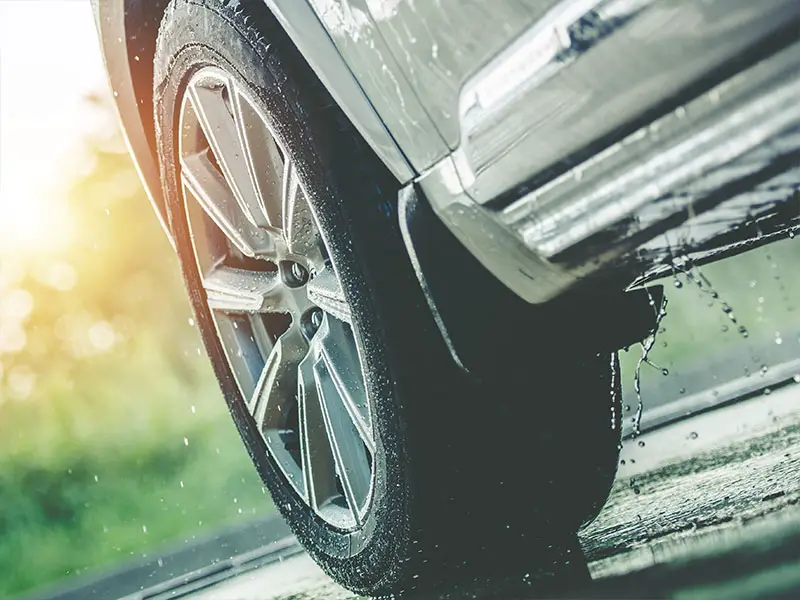
All-Weather Tires
All-Weather Tires are essentially All-Season tires that prioritize winter performance more than a typical All-Season tire. All-Weather tires will give up some performance in dry and warmer conditions to achieve better cold-weather handling and be better able to deal with snow and slush.
All-Weather tires are ideal for areas that may be unable to justify the purchase of dedicated Winter tires but see more winter conditions than the typical All-Season tire is designed to cope with.
Highway Tires
Highway tires are light truck and SUV tires designed for comfort and long tread life. Highway tires are most likely to be all-season tires. They can also handle heavier loads of larger vehicles that you may use for hauling additional weight.
Highway tires are not meant for off-road use, obviously but are an excellent choice for people looking to get a very long-lasting tire for their truck or SUV that doesn’t demand a lot of performance characteristics.
Low Rolling Resistance Tires
Low rolling resistance tires increase fuel efficiency by reducing the effort required to propel your car or truck. It may seem like a significant improvement couldn’t be possible by making a tire roll easier, but you can see noticeable differences over time.
Several tactics are used to improve the rolling resistance of a tire, such as a smaller contact patch, more rigid sidewall designs, less aggressive tread patterns. While these adjustments will reduce rolling resistance, they usually come at a slight tradeoff in performance characteristics.
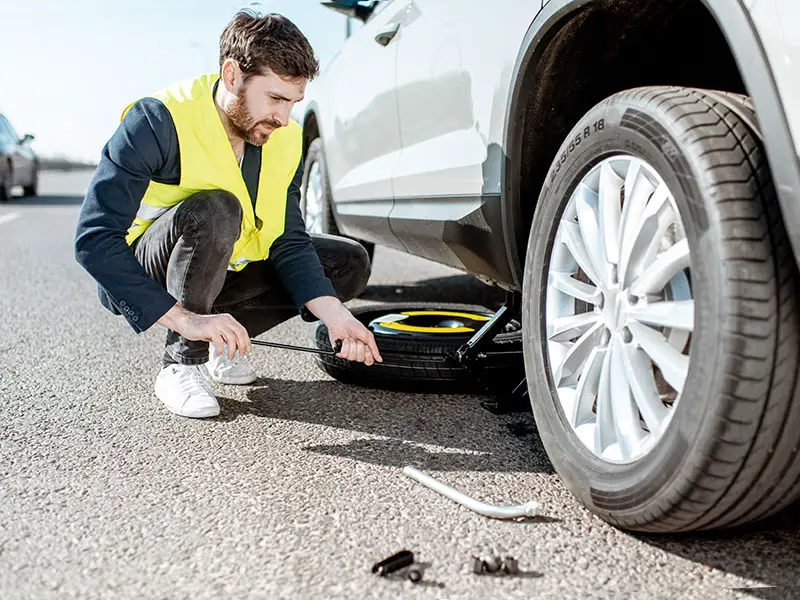
Run-Flat Tires
Run-flat tires can be driven on for up to 50 miles after getting a flat tire. You shouldn’t exceed 50 miles per hour to ensure there isn’t damaging heat buildup in the sidewall that can lead to failure.
Run-flats are popular on some cars and trucks that don’t have spare tires. They do not, however, come on all vehicles without spare tires. So, don’t assume that just because you don’t have a spare that you have run-flat tires.
The way run-flat tires work is by designing an extremely strong tire sidewall that can hold up the weight of your car or truck for some time without breaking down. Eventually, the heat buildup will cause the sidewall to fail, so you can only drive just so fast and only for just so long.
Run-flats tend to receive complaints from more sensitive drivers about comfort. Since the sidewalls are extremely rigid, they are much less capable of absorbing sharp bumps like potholes
If you have run-flat tires installed, it will be challenging to know when you get a puncture without a tire pressure monitoring system. Most cars and trucks these days come with them installed. If you don’t have one, I would recommend avoiding run-flats.
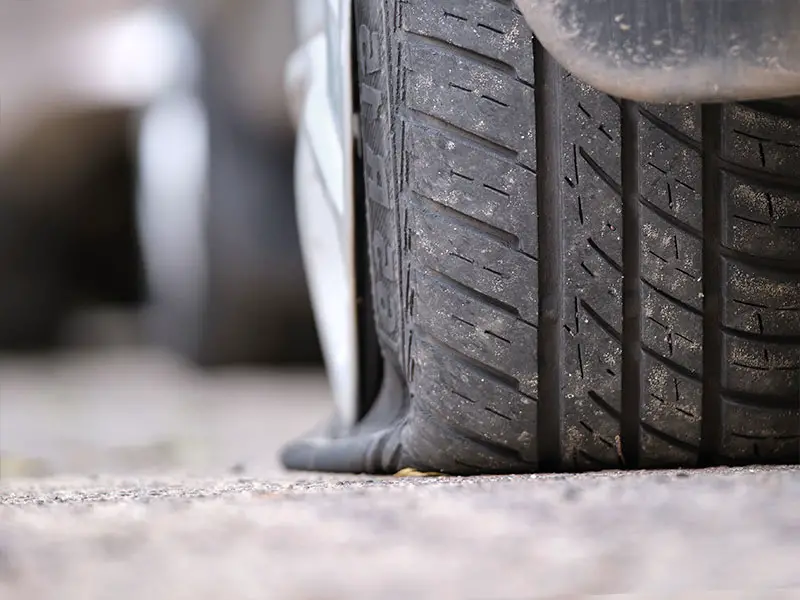
Self-Sealing Tires
Self-sealing tires are designed to be able to seal small punctures. They can be considered an alternative to run-flats in a sense. While you can’t continue driving if your tire is flat, you’re much less likely to sustain a flat tire.
Self-sealing tires generally work but include a layer above the tread that, when punctured, will release a sealant that will fill the puncture and prevent air loss. Likely, you’ll never know you had a puncture since the sealing layer will seal the penetration instantly, and your tire will never lose air.
Since it doesn’t lose air, your tire pressure monitoring system will not register a problem either. Not knowing you have had a puncture isn’t an issue, though, since the sealant solved the problem before it became an issue that would need to be handled.

Low-Profile Tires
Low-profile tires refer to tires with a particularly short sidewall – the distance between the tire tread and the rim. A tire is generally considered low-profile if the sidewall aspect ratio is 50 or less.
The sidewall aspect ratio is one of the numbers listed on all tire sidewalls and is part of the tire size. For instance, a tire with a size of 255/40/19 would be considered a low-profile tire.
The middle number is the sidewall aspect ratio. The first number is the width of the tire tread in millimeters. The second number, the sidewall height, is the percentage of the tread width.
In this case, the sidewall height is 40 percent of 255 millimeters which equals 102 millimeters or just over 4 inches for us Americans. The last number is the rim size in inches.
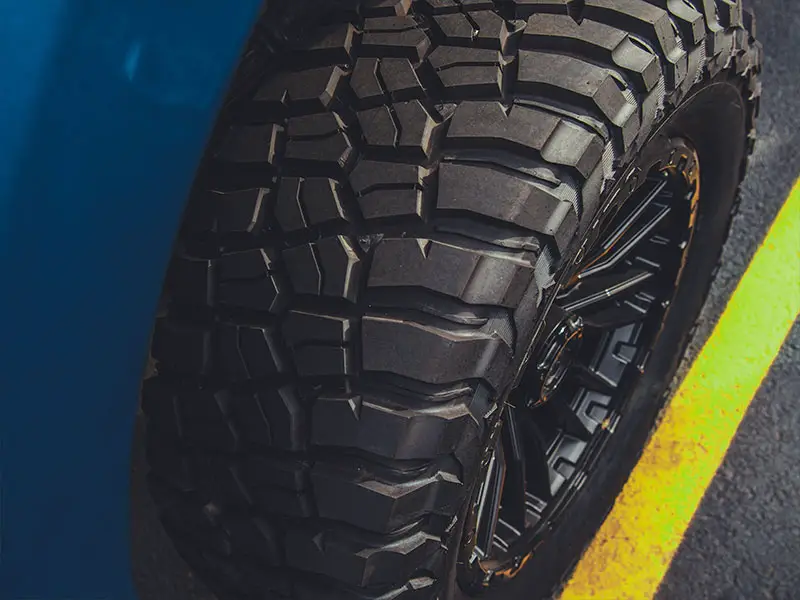
All-Terrain Tires
All-terrain tires are meant for both on-road and off-road, although on-road use is the primary focus of all-terrain tires. While most common for use as truck tires, you can use them for any passenger vehicle that frequently sees use off paved roads.
All-terrain tires are great for mild off-road excursions and people who often travel on dirt and gravel roads. Their more open-block design allows them to grip rougher terrain better, but they can still perform well on the street.
All-terrain tires are not as good an alternative to winter or all-season tires for use on snowy roads. While all-terrain tires can deal well with some snow off-road, all-season and winter tires are much better and maintain traction on snowy streets.
The rubber in all-terrain tires is not optimized for winter temperatures. All-terrain tires are inferior at dealing with cold weather due to the rubber compound being designed to withstand sharper rocks, sticks, and other debris. To increase durability, the rubber is stiffer than most other tire formulations. When temperatures drop, all-terrain tires lose a lot of elasticity and a lot of traction.
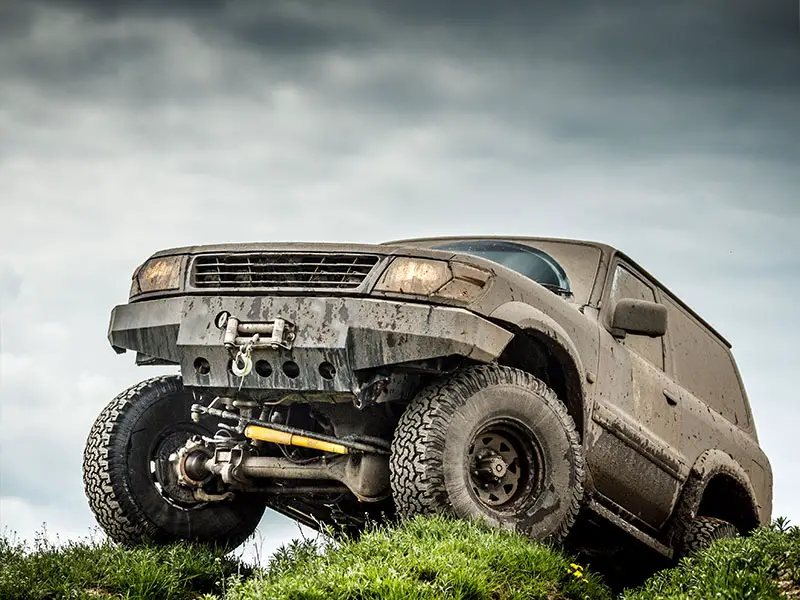
Off-Road Tires
Off-road tires are primarily meant for off-road use, but many can be used for on-road use, even at highway speeds. Off-road tires are ideal for situations where they will rarely see street use. If you often find yourself using them on the road, you may want to consider switching to an all-terrain tire to improve safety and longevity.
Mud Tires
Mud tires are a specific type of off-road tire that works best in muddy conditions and more extreme off-road conditions. For more basic off-roading, they’re far more aggressive and capable than necessary.
Unless specifically designed for winter use, mud tires will not perform as well in snow and cold weather due to the rubber formulation used. Whether they are explicitly designed for snow or not, they will not perform the best in snow on-road. The tread design may help offset this some, but a dedicated tire for your situation is always best.
Mud tires are also not ideal for use in the rain and are prone to hydroplane. Tread patterns optimized to evacuate water aren’t compatible with tread patterns designed to grip well over rocks and other extreme off-road terrains.
You can use mud tires on-road, but they have serious drawbacks. On-road driving will reduce gas mileage significantly compared to proper on-road tires. Mud tires will also wear down their tread quickly when driven on pavement. Additionally, they will produce a significant amount of noise.
Rock Crawler Tires
Rock crawling tires are designed for probably the most extreme of off-roading tasks. They typically have a very soft and grippy yet very strong compound. The tread patterns are incredibly aggressive, and the carcass is often Kevlar-reinforced to ensure sharp rocks won’t puncture the tire.
These tires are quite expensive and will wear down quickly on pavement. The cost makes them a particularly poor choice for daily driving. You should switch your tires out if you often drive it on the street but occasionally do off-road and rock crawling.
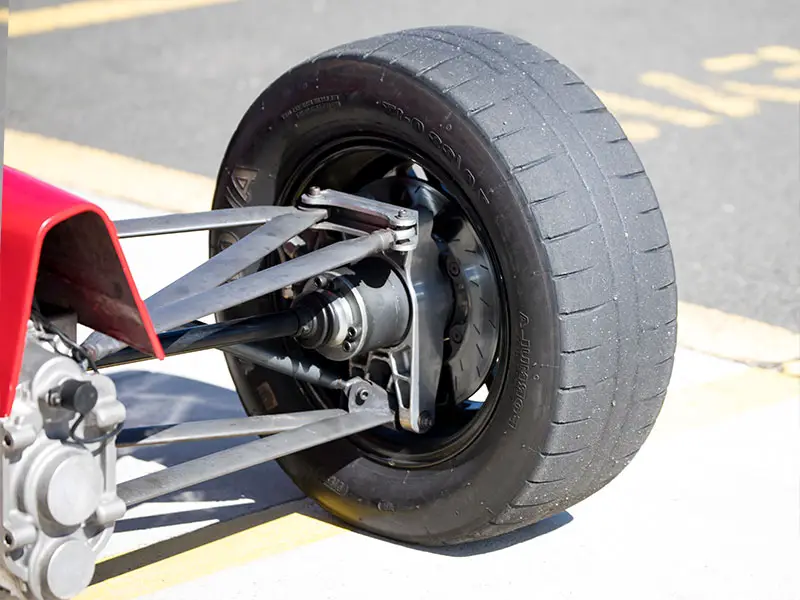
Track Tires
Track tires are, as the name implies, tires designed for use on race tracks. They come in 2 primary flavors:
Street-Legal Track Tires
Street-legal track tires are legal to be used on public roads but better for use on the track. They are great if you don’t want to trailer your car to the track and would rather drive it there. While street-legal, track tires of any kind aren’t great for daily driving. Tread life will be incredibly short, and unless explicitly designed for wet traction, they’ll be extremely poor at maintaining traction in the rain.
Track-Only Tires
Track-only tires are not Department Of Transportation (DOT) approved and can’t legally be used on public roads. Not being street-legal means that they don’t need to conform to standards that might limit their ability to perform well on a track surface so they can increase grip further than any street-legal tire could achieve.
Airless Tires
Airless tires for passenger vehicles haven’t hit the market yet (as of the writing of this article), but they are expected to become an available option within a couple of years. These tires replace the air-filled cavity with flexible rubber supports. The primary advantage of an airless tire is the fact it can’t go flat. They do have some downsides currently that have prevented them from making it to market, though. The 2 main disadvantages are expense and weight.
4 Tire Type Codes
All tires have a tire code that describes the size and other aspects of the tire. The first letter of the tire code is the official tire type.
The 4 types of tires indicated in the tire code on the sidewall of your tires are very broad and general categorizations. The 2 you’re going to be interested in are Passenger (P) and Light Truck (LT) when it comes to your daily driver.
Passenger Tires (P)
Passenger tires are for sedans, hatchbacks, minivans, and some crossover vehicles. These are the most popular types of tires.
Light Truck Tires (LT)
Light truck tires are for heavier designs such as traditional pickups, SUVs, full-size vans, and larger crossover vehicles.
Trailer Tires (ST)
Trailer tires are designed completely differently from standard passenger vehicle tires. Trailer tires can handle extreme loads and do not need handling performance, so the tread designs and rubber compounds are entirely different from a car or truck tire.
Trailer tires are a one-trick pony essentially. They do an excellent job of helping haul objects in a straight line or a turn more slowly.
Spare Tires (T)
Spare tires have become rarer and rarer, with manufacturers opting not to include a spare tire of any kind in many new cars and trucks. Often, they are replaced with an emergency inflation kit that can patch small punctures.
While you might have a full-size spare on the back of your Jeep or under the bed of your truck, dedicated spare tires are compact and meant for short-term use. They aren’t capable of withstanding high speeds or extended driving. They’re smaller than the full-size tire they’re replacing to save space within the trunk or hatch of your car or SUV.
2 Types Of Tire Construction
When it comes to passenger vehicle tires, almost everything is going to be a radial tire construction. Bias-ply is an older design that radials have superseded. Bias-ply can still be found, however, in some limited applications.
Bias Ply Tires
Bias-ply tires were the tire design of choice until the 1970s and consisted of overlapping nylon fabric plies angled at 30 or 40 degrees. These designs are still a good choice for some applications, such as construction vehicles. But radial tires are a significant improvement for passenger vehicles, making bias-ply typically only available for use on classic cars to maintain the proper aesthetic and be faithful to the era.
Radial Tires
Radial tires are constructed with steel belts, and the plies run radially – hence the name. This design improves durability, comfort, and handling. It enhances strength but allows for more flexibility in the sidewall. With a solid yet flexible sidewall, radial tires can provide more comfort and better road-holding characteristics.
Frequently Asked Questions
WHAT IS THE MOST COMMON TYPE OF TIRE?
All-Season Touring Radials are the most common type of tire for passenger and light truck vehicles. These tires are designed to be used year-round and handle daily driving needs exceptionally well.
HOW DO I KNOW WHAT KIND OF TIRES I NEED?
Understanding the types of tires available and comparing their abilities with your unique situation and needs will get you most of the way toward knowing the best tires for your car or truck. But you should also know the requirements of your vehicle.
I recommend looking up the original equipment tires for your vehicle and ensuring that the tires you choose meet or exceed the UTQG ratings of the OEM tire. You can learn more about picking the correct tires in our article on How To Buy Tires.
WHAT IS THE MOST POPULAR TIRE?
The most popular type of tire is the All-Season Touring Radial. Michelin, Bridgestone, Goodyear, and Continental are the most popular brands. It is difficult to say which specific tire is the most popular, but any all-season touring tire from these manufacturers will be extremely popular.
DOES IT MATTER WHAT TIRES YOU BUY?
The type of tire matters quite a bit, as you have hopefully learned from this article. You should also ensure the UTQG rating of the tires the manufacturer fitted with your vehicle is met or exceeded by the UTQG rating of the tires you’re buying.
You can learn more about picking the correct tires in our article on How To Buy Tires.
WHAT DOES M & S MEAN ON A TIRE?
M & S stands for Mud & Snow. M&S (M+S or MS) tires are particularly well suited for wet and snowy weather. They are not as capable of dealing with snow as a dedicated Winter tire however.
M&S tires don’t have the rubber formulation of a true Winter tire so they can’t deal with freezing temperatures as well. But they do have tread patterns more similar to Winter tires to help improve traction in snow, slush, and mud.
CAN ALL-WEATHER TIRES BE USED ALL YEAR?
All-Weather tires are specifically designed to be used all year round for climates that experience colder temperatures and more winter weather but don’t quite have the severe winter weather that would require the purchase of Winter tires.
CAN I USE ALL SEASON TIRES IN WINTER?
All-Season tires can be used all year round, including winter. They are not designed to deal with freezing temperatures or more than light snow.
An All-Weather tire is a more winter-focused tire that is better suited to be used year round in climates that experience more snow and slush but still don’t experience much freezing conditions.
For climates that experience frequent freezing temperatures and heavier snow, a dedicated winter tire is the best choice. Winter tires shouldn’t be used in warmer weather so switching back to an All-Season or Summer tire is required.
CAN I USE WINTER TIRES IN SUMMER?
Winter tires are a very poor choice for warmer weather. Rubber compounds in Winter tires are specifically formulated to remain flexible in colder temperatures.
In warmer temperatures the rubber becomes too soft. This causes the tire tread to wear down very quickly. It also causes the tread blocks to flex and give significantly more than they should which reduces traction and handling.
WHAT DOES THE MOUNTAIN AND SNOWFLAKE SYMBOL ON TIRES MEAN?
The mountain and snowflake icon is a certification by the US Tire Manufacturer’s Association that confirms the tire is capable of severe winter and snow conditions.
Resources
Below are some links you may find helpful when learning about tires
